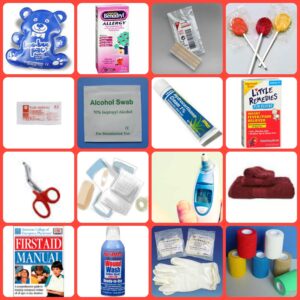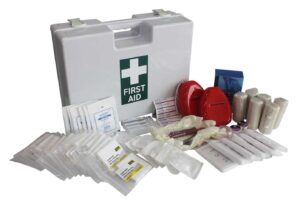Back to: Physical and Health Education JSS 2
Welcome to class!
In today’s class, we shall be talking about the content of a good first aid box. Please enjoy the class!
Content of a Good First Aid Box

Hey there, future lifesavers! Today, we’re diving into the world of first aid, specifically the treasure trove of supplies known as a first aid kit. Think of it as your personal arsenal against bumps, bruises, and boo-boos, ready to transform you into a campus hero (not a zero!) when emergencies strike.
But what should this magical box contain? Let’s break it down into categories, shall we?
Wound Care:
Bandages: The holy grail of first aid! Stock up on adhesive bandages in various sizes (think butterfly bandages for those pesky nose scrapes!), gauze pads (sterile squares for larger wounds), and conforming bandages (elastic rolls for sprains and strains).
Antiseptic wipes and solutions: These are your germ-fighting buddies, cleaning wounds and preventing infections. Opt for alcohol-free options for sensitive skin.
Tweezers: Tiny thorns and pesky splinters? Tweezers will be your knight in shining armor, plucking out those invaders with precision.
Burn Care:
Sterile burn dressings: These special dressings are designed to cool burns and prevent further damage. Look for hydrogel dressings for minor burns.
Aloe vera gel: This natural wonder soothes and heals minor burns, providing relief from that stinging sensation.
Pain Relief:
Instant cold packs: Ideal for sprains, strains, and reducing swelling. Bonus points for reusable packs!
Pain relievers: Over-the-counter medications like ibuprofen or acetaminophen can be lifesavers for headaches, muscle aches, and mild fever. Remember, consult with a healthcare professional before using these.
Other Essentials:

Scissors: For cutting bandages, tape, and anything else that needs a trim.
Safety pins: Secure dressings and slings with these handy helpers.
Disposable gloves: Protect yourself from bodily fluids and keep things hygienic.
Thermometer: Keep track of fevers and monitor potential health concerns.
First-aid manual: Your reference guide in a crisis, providing clear instructions on how to handle common injuries and illnesses.
Remember, having a well-stocked first aid kit isn’t just about being prepared, it’s about being proactive in caring for yourself and others. So go forth, my friends, and spread the knowledge of first aid! You never know when you might be called upon to be a campus hero.
P.S. Don’t forget to have fun with it! Decorate your kit, personalize it, and make it your own little first-aid fortress. After all, even heroes need a touch of personality.
Now go out there and be the difference!
We have come to the end of today’s class. I hope you enjoyed the class!
In the next class, we shall be discussing Situations and conditions that requires first aid.
In case you require further assistance or have any questions, feel free to ask in the comment section below, and trust us to respond as soon as possible. Cheers!
Evaluations:
- Imagine you’re at a crowded campus event and someone suffers a minor cut. What essential items from your first aid kit would you use to treat the wound, and why?
- Compare and contrast the use of sterile gauze pads and non-stick dressings for different types of wounds. When would each be the preferred choice?
